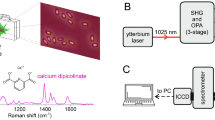Abstract
A variety of laser-based standoff techniques are currently being developed for the detection of explosives. Many approaches focus on the detection of NO as an indicator for the presence of nitro-based explosives. One of these approaches uses lasers to vaporize the explosive molecules residing at or near a surface, photo-dissociate the molecules resulting in vibrationally hot NO, and then perform laser-induced fluorescence on the vibrationally hot NO. Most related reports have focused on using 236 nm or 247–248 nm for the laser excitation of vibrationally hot NO. In addition, a recent report suggests the use of 532 nm to desorb, vaporize, and photo-fragment explosive samples. We report here on energy transfer from laser-excited N2 to NO and its consequences for the detection of nitro-based explosives. A potential interference mechanism was found for using 532 nm and 236 nm. The interference mechanism is based upon multi-photon excitation (532 nm) or two-photon excitation (236 nm) into excited states of molecular nitrogen and subsequent energy transfer from nitrogen to NO, followed by NO luminescence. Such interference mechanisms highlight the complexity of the explosive detection problem and the need for complementary approaches to improve the detection capabilities.
Similar content being viewed by others
References
D.S. Moore, Rev. Sci. Instrum. 75, 2499 (2004)
S. Singh, J. Hazard. Mater. 144, 15 (2007)
J.I. Steinfeld, J. Wormhoudt, Annu. Rev. Phys. Chem. 49, 203 (1998)
D.O. Henderson, R. Mu, Y.S. Tung, G.C. Huston, Appl. Spectrosc. 49, 444 (1995)
J. Janni, B.D. Gilbert, R.W. Field, J.I. Steinfeld, Spectrochim. Acta, Part A, Mol. Biomol. Spectrosc. 53, 1375 (1997)
N.F. Fell, J.M. Widder, S.V. Medlin, J.B. Morris, R.A. PesceRodriguez, K.L. McNesby, J. Raman Spectrosc. 27, 97 (1996)
K.L. McNesby, C.S. Coffey, J. Phys. Chem. B 101, 3097 (1997)
K.L. Mcnesby, J.E. Wolfe, J.B. Morris, R.A. Pescerodriguez, J. Raman Spectrosc. 25, 75 (1994)
M. Gaft, L. Nagi, Opt. Mater. 30, 1739 (2008)
A. Portnov, I. Bar, S. Rosenwaks, Appl. Phys. B, Lasers Opt. 98, 529 (2010)
D.D. Wu, J.P. Singh, F.Y. Yueh, D.L. Monts, Appl. Opt. 35, 3998 (1996)
H. Zuckermann, G.D. Greenblatt, Y. Haas, J. Phys. Chem. 91, 5159 (1987)
A. Mukherjee, S. Von der Porten, C.K.N. Patel, Appl. Opt. 49, 2072 (2010)
B. Arnold, L. Kelly, J.B. Oleske, A. Schill, Anal. Bioanal. Chem. 395, 349 (2009)
J.L. Gottfried, F.C. De Lucia, C.A. Munson, C. Ford, A.W. Miziolek, Detection of energetic materials and explosive residues with laser-induced breakdown spectroscopy: II. Stand-off measurements, in Army Research Laboratory (2007)
J.L. Gottfried, F.C. De Lucia, C.A. Munson, A.W. Miziolek, Anal. Bioanal. Chem. 395, 283 (2009)
Y.Q. Guo, A. Bhattacharya, E.R. Bernstein, J. Phys. Chem. A 113, 85 (2009)
C. Mullen, M.J. Coggiola, H. Oser, J. Am. Soc. Mass Spectrom. 20, 419 (2009)
J. Shu, I. Bar, S. Rosenwaks, Appl. Opt. 38, 4705 (1999)
J. Shu, I. Bar, S. Rosenwaks, Appl. Phys. B, Lasers Opt. 71, 665 (2000)
J. Shu, I. Bar, S. Rosenwaks, Appl. Phys. B, Lasers Opt. 70, 621 (2000)
J.D. White, F.A. Akin, H. Oser, D.R. Crosley, Appl. Opt. 50, 74 (2011)
C.M. Wynn, S. Palmacci, R.R. Kunz, K. Clow, M. Rothschild, Appl. Opt. 47, 5767 (2008)
C.M. Wynn, S. Palmacci, R.R. Kunz, M. Rothschild, Opt. Express 18, 5399 (2010)
T. Arusi-Parpar, D. Heflinger, R. Lavi, Appl. Opt. 40, 6677 (2001)
G. Laufer, R.H. Krauss, J.H. Grinstead, Opt. Lett. 16, 1037 (1991)
W.B. Lewis, W.R. Wadt, Chem. Phys. Lett. 78, 266 (1981)
W.G. Clark, D.W. Setser, J. Phys. Chem. 84, 2225 (1980)
C.H. Dugan, J. Chem. Phys. 45, 87 (1966)
T. Hikida, Y. Mori, J. Chem. Phys. 69, 346 (1978)
L.G. Piper, L.M. Cowles, W.T. Rawlins, J. Chem. Phys. 85, 3369 (1986)
J.M. Thomas, D.H. Katayama, Chem. Phys. Lett. 214, 250 (1993)
A. Lofthus, P.H. Krupenie, J. Phys. Chem. Ref. Data 6, 113 (1977)
J.B. Nee, C.Y. Yuan, J. Hsu, W.J. Chen, J.C. Yang, Chem. Phys. 315, 81 (2005)
D.E. Shemansky, J. Chem. Phys. 51, 689 (1969)
P.G. Wilkinson, J. Chem. Phys. 30, 773 (1959)
G. Dilecce, P.F. Ambrico, S. De Benedictis, Plasma Sources Sci. Technol. 14, 561 (2005)
S.V. Pancheshnyi, S.M. Starikovskaia, A.Y. Starikovskii, Chem. Phys. Lett. 294, 523 (1998)
T.B. Settersten, B.D. Patterson, W.H. Humphries, J. Chem. Phys. 131, (2009)
R.A. Young, G.A.St. John, J. Chem. Phys. 48, 898 (1968)
J. Luque, D.R. Crosley, J. Phys. Chem. A 104, 2567 (2000)
J. Le Calve, J. Chem. Phys. 58, 1446 (1973)
F. Hellberg, S. Rosen, R. Thomas, A. Neau, M. Larsson, A. Petrignani, W.J. van der Zande, J. Chem. Phys. 118, 6250 (2003)
Author information
Authors and Affiliations
Corresponding author
Rights and permissions
About this article
Cite this article
Wen, B., Eilers, H. Potential interference mechanism for the detection of explosives via laser-based standoff techniques. Appl. Phys. B 106, 473–482 (2012). https://doi.org/10.1007/s00340-011-4713-y
Received:
Revised:
Published:
Issue Date:
DOI: https://doi.org/10.1007/s00340-011-4713-y




